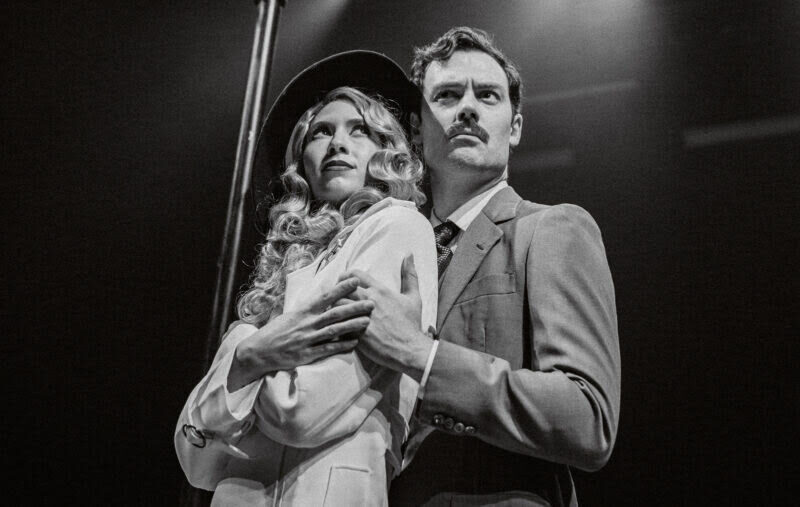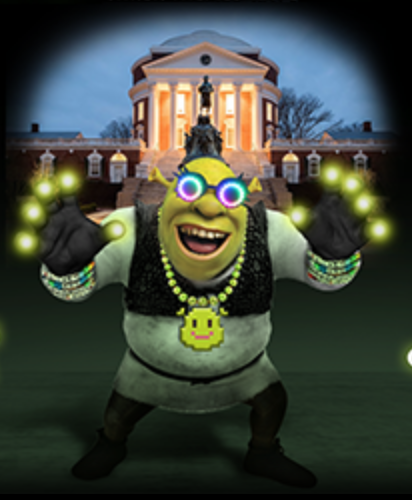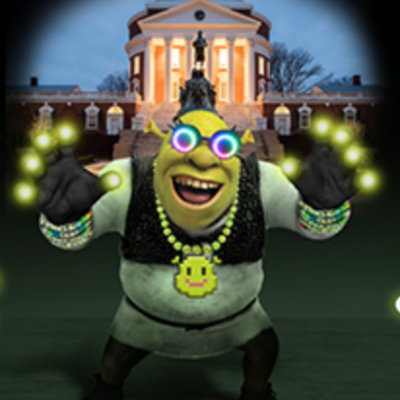 “Pitch”
“Pitch”
Zen Monkey Project
McGuffey Art Center
Continues November 15-16 and 18-19
dance The term “modern dance” conjures a lot of ideas, many of them stern, such as humorless chorines in scratchy woolen tights performing works that illuminate the sharp treacheries of the choreographer’s soul amidst a setting of bare overhead light bulbs. Informality, humor and mutual support hardly jump to mind as what lies in wait when the curtain rises.
So the fact that Katharine Birdsall has subverted stereotypes by putting on a friendly lunchtime concert of charming solos and surprising partnering sequences to lively harpsichord music in a bright studio (a onetime art gallery) and that she gets the whole thing done in an hour with time to spare should be reason enough to endorse the latest work from one of the founders of local modern dance collective the Zen Monkey Project. Add to that spurts of pretty good dancing, not to mention Birdsall’s reliable eye for costumes and ensemble work, and a couple of visual puns, and it’s enough to bury the most unfortunate modern dance stereotypes.
I’ve been watching Birdsall choreograph and dance for a long time now (is it eight years already?), and I still maintain that she is her own best vessel. One of the reasons is technique. Where younger dancers who come out of college programs tend to leave their fingers a bit curled, their knees a bit bent, their butts a bit protruded, their heads a bit tucked no matter how urgently the dance phrases demand a clean, straight line and an outward gaze, Birdsall differentiates between slicing attack and coy introversion as her work calls for it. So a solo sequence for Birdsall finds her clearly quoting a flamenco dancer and a bullfighter amidst luscious to-the-right spirals. Meanwhile, her feet, unable to deny her childhood ballet training, rest in a perfect, satisfying fifth position.
This is not to say that Birdsall’s choreography is rewarded by her performance alone. Not at all. Her opening, for one thing, “Improvisation with Foreshadowing,” finds four dancers conjuring lovely images of physical support and tenderness. I’ve seen these “Pieta”-like moments in her work before: a couple of dancers arrayed on the floor with one cradling the other Mother Mary-style until they crawl over and around each other to an equally supportive but new shape. And there are truly lovely bits where one dancer cups another’s back-of-the-neck while she turns or shifts—as tender a metaphor for backing up another person’s intentions as I’ve ever seen in the middle of the day! The final sequence of “Pitch,” which is what Birdsall calls the seven-part work in total, is rollicking and energized with plenty of light jumps and wall-supported handstands and cartwheels. And there’s more of that strong-woman partnering, in which everybody (Jessie Laurita-Spanglet, Aaron Wine, Kelly East and Emily Oleson) looks good.
Modern dance may always be suspect in some quarters. But for another week at least, thanks to Katharine Birdsall, Studio 11 in McGuffey Art Center will not be among them.—Cathy Harding
She Wants Revenge,
with Pretty Girls Make Graves,
and Monsters Are Waiting
Satellite Ballroom
November 10
music The interior of the Satellite Ballroom is like that of a shotgun shack—a single open space that is at least twice as long as it is wide, stage at one end, bar at the other. The club’s structure helps measure the success of a band: Put on a dynamic show, and the crowd will swing, sway and dance at the front. Fall flat, and crowd members will turn their backs and move to the bar, where the noise is a little less intrusive.
DJs-turned-Interpol-fans She Wants Revenge managed to accomplish the former at a packed ballroom, thanks to the company they keep in the press (Depeche Mode and Joy Division comparisons every other paragraph) and on tour (supporting act Pretty Girls Make Graves will upstage the main event every night of the week).
As a result, opening act Monsters Are Waiting rode the coattails of popular music and received a warmer welcome than most supporting bands. Left alone, The Monsters’ keyboard fills were plodding, the vocals whispy. Properly layered, however, the Cure-savvy keys and Telecaster blasts rightly earned a few toe-taps and handclaps.
Seattle’s Pretty Girls Make Graves is an animal far different from its tourmates—different as a tiger among turtles, the more vicious and attractive beast at the zoo. Pretty Girls also maintains one of the best rhythm sections in modern rock, and proved it in a danceable set that drew heavily from 2003’s masterful The New Romance.
It was the evening’s peak. The opening combination of “Something Bigger, Something Brighter” and “The New Romance” brought bright guitar flourishes and arrhythmic, engaging beats—the crowd marveled and moved in equal parts. Sultry vocalist Andrea Zollo channeled The Pretenders’ Chrissie Hynde in her finer moments, teasing the front row with winks and finger-wags aplenty.
Though live staples “Speakers Push The Air” and “All Medicated Geniuses” were sorely missed, Pretty Girls filled in the gaps admirably, amplifying latent numbers from their latest album, including the slinky, sinister “Nocturnal House,” and “Parade,” a finale that threw a rollicking accordion melody into the mix. The last “opening act” left the stage, and the crowd pushed to the front of the ballroom, eager for headliners She Wants Revenge.
The problem with big-name comparisons is that, if a band fails to surpass its influences, then it fails before a larger crowd. A major label deal with Geffen and comparisons to a handful of neo-New Wave bands earned She Wants Revenge a sizable audience, but their inability to change tempo, song structure, or monotonous vocals during their set made them a forgettable act. “Red Flags and Long Nights” ran together with “Tear You Apart” and “I Don’t Want to Fall in Love.” Little seemed planned to invigorate the performance—fittingly, the band’s light show remained monochromatic.
Onstage, the band seemed as nonplussed as their audience—neither knew how to follow the Pretty Girls performance. Slowly, the enthusiasm seeped out of the evening, and the crowd trickled to the back, reopening the chasm in the middle of the ballroom.—Brendan Fitzgerald The Black Parade
The Black Parade
My Chemical Romance
Reprise Records
cd One of the enduring tensions in emo, My Chemical Romance’s stomping grounds, is that fast, abrasive guitar rock is the default musical container for lyrical ideas that can be more sensitive or sappy than the most delicate James Taylor side. Emo emerged from punk, which explains the musical form, but The Black Parade, the b
and’s third studio album, asks a question that has occurred to few others: Might all this angst and soul-searching be better suited to the strutting pomp of a Broadway musical?
So The Black Parade is of course a concept album, in the vein of Pink Floyd, The Beatles and Queen—three bands MCR admits to listening to heavily. It tells the story of an unnamed man with terminal cancer contemplating his short life from his deathbed. “Welcome to the Black Parade,” the album’s leadoff single, released in September, raised expectations for the album considerably. It’s a pocket symphony with a dangling wallet chain, complete with martial drums to evoke the character’s forlorn recollections of seeing a marching band with his dad, a vocal break to make Jon Anderson weep, and a spine-tingling chorus hook centered on the phrase “We’ll carry on” that evokes Styx’s “Come Sail Away.”
This is music anyone who’s ever cried along to an Andrew Lloyd Webber song would be immensely comfortable with.
Gerard Way’s singing has continued to improve in tone and power, and the band has mastered the art of the evocative chord change, able to alternate between meaty mid-tempo ballads (“I Don’t Love You” brings to mind “Today” by Smashing Pumpkins, another big influence) and the ersatz-Aerosmith boogie of “House of Wolves” with the flick of a pickup switch. There’s even a serious curveball in the form of the vaguely Brechtian “Mama,” which starts with a Fiddler On the Roof-like jig and ends with a verse from Liza Minnelli, her voice processed to sound like her, er, mama singing down through the ages at 78 revolutions per minute.
The crackly coda of “Mama” offers a welcome dose of theater, and “Welcome to the Black Parade” is rock bombast at its best. Still, the album as a whole too often lacks the courage of its conceptual convictions. The Great Albums MCR draw from thought outside the rock box and integrated popular music from across eras; The Black Parade seems stuck between about 1993, when Smashing Pumpkins released Siamese Dream and 2005, when Green Day released American Idiot. Two of the better moments actually come when the concept slips into the background and MCR resumes being a catchy rock band. “Teenagers,” despite its dubious connection to the album’s story, has the massive hook Rivers Cuomo has been trying to write ever since Weezer’s debut. “Sharpest Lives” alludes to Shakespeare and keeps bringing up vampires, but the best thing about it is a swooping chorus that brings to mind “You Give Love a Bad Name” by Jersey homies Bon Jovi.
My Chemical Romance still excels at pop-punk, but everything about The Black Parade—from the illustrations on the terrifically engaging packaging (which envisions MCR as a brass band marching through a Tim Burton film) to a narrative that examines loss, morality and regret around every turn—calls for more imagination than they display here. It may not be fair to expect so much and then be disappointed when an album swinging for the seats only manages a ground-rule double. But when a band positions itself in lofty company like The Beatles, Queen, and Floyd, that’s the risk they take.—Mark Richardson




